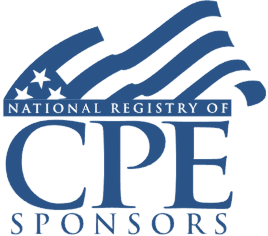Welcome! Save 30% on all CLE, CPE, and Professional Skills webinars, plus 15% off any annual pass with code HOLIDAY25
About the Course
Introduction
This webinar will address the preparation of the cash flow statement in accordance with FASB ASC 230 and offer practical advice to expedite its completion and properly report its components. Our panel of accounting professionals will provide comprehensive examples, illustrative cash flow statements and walk you through reconciling the entries on the cash flow statement with other required financial statements.
Description
The cash flow statement may be the most complex and least understood of the primary financial statements. It is wrought with choices and classification issues that practitioners must consider. The first hurdle is defining cash. According to ASC 230, cash includes "not only currency on hand but demand deposits with banks or other financial institutions." Also considered cash are cash equivalents that are: "(a) Readily convertible to known amounts of cash (b) So near their maturity that they present insignificant risk of changes in value because of changes in interest rates." Additionally, cash could be restricted or not and should be reported accordingly.
Once accountants determine what is included as cash, they must decide whether the indirect or direct method is better or required. Then, each cash transaction must be reported within the appropriate section of the statement, either investing, financing, or operating. The classification of an item is not always easily determined, and transactions can appear in more than one section. The purchase of a business, the sale of equipment or property, and theft or casualty losses can be difficult to classify. Perhaps the most troublesome aspect comes after all transactions are classified, and the accountant has a draft of the cash flow statement. The statement itself must reconcile and reconcile with the other financial statements presented.
Listen as our panel of A&A experts guides accounting and auditing professionals through preparing cash flow statements with a particular emphasis on reconciling this intricate statement.
Presented By

Ms. Hampton is a Manager in the Audit and Assurance Department. She attended the University of Alabama, where she earned a Master of Accountancy in 2009 and a Bachelor of Science in Accounting, graduating cum laude in 2008. Ms. Hampton has over 12 years of experience in public accounting, providing audits, reviews, compilations, and preparations of financial statements to clients in various industries. She is certified as a Peer Review Captain and works with the peer review team to provide value to firms around the country. In addition to these services, Ms. Hampton has several years of experience in solutions and tax and provides support to clients in these areas. Her industry focus includes government contracting, employee benefit plans, construction, and not-for-profit agencies.​

Ms. Peters is a business growth and profitability advisor with a passion for helping clients achieve their dreams. She works with service-based businesses, focusing her expertise on law firms and construction contractors. Ms. Peters utilizes her credentials, education and 20+ years of experience as a Certified Public Accountant and Chartered Global Management Accountant in providing clients with insight to their business and acts as a partner in strategic planning and execution.
-
BARBRI is a NASBA CPE sponsor and this 110-minute webinar is accredited for 2.0 CPE credits.
Date + Time
- event
Wednesday, November 15, 2023
- schedule
1:00 p.m. ET./10:00 a.m. PT
- Introduction: purpose of cash flow statements
- Guidance--FASB ASC 230 Statement of Cash Flows
- Methods
- Direct
- Indirect
- Sections of the cash flow statement
- Special items
- Disclosures
- Reconciliation and worksheets
- Common errors
- Illustrative examples
The panel will cover these and other critical issues:
- Reconciling the entries of the cash flow statement
- When the direct method should be selected for preparation of the cash flow statement
- Common errors to avoid when preparing the cash flow statement
- Reporting special items on the cash flow statement
- Required cash flow statement disclosures
Learning Objectives
After completing this course, you will be able to:
- Determine stpes to expedite completion of the cash flow statement
- Identify components of the financial section of the cash flow statement
- Decide when the direct method must be used for the cash flow statement
- Ascertain how to classify certain complex transactions on the statement of cash flows
- Field of Study: Accounting
- Level of Knowledge: Intermediate
- Advance Preparation: None
- Teaching Method: Seminar/Lecture
- Delivery Method: Group-Internet (via computer)
- Attendance Monitoring Method: Attendance is monitored electronically via a participant's PIN and through a series of attendance verification prompts displayed throughout the program
- Prerequisite: Three years+ business or public firm experience, preparing reviewed, compiled, and audited financial statements and the relative disclosures. Specific knowledge and understanding of GAAP, SSARS, and peer review policies.

BARBRI, Inc. is registered with the National Association of State Boards of Accountancy (NASBA) as a sponsor of continuing professional education on the National Registry of CPE Sponsors. State boards of Accountancy have final authority on the acceptance of individual courses for CPE Credits. Complaints regarding registered sponsons may be submitted to NASBA through its website: www.nasbaregistry.org.

BARBRI CE webinars-powered by Barbri-are backed by our 100% unconditional money-back guarantee: If you are not satisfied with any of our products, simply let us know and get a full refund. Contact us at 1-800-926-7926 .
Unlimited access to premium CLE courses:
- Annual access
- Available live and on-demand
- Best for attorneys and legal professionals
Unlimited access to premium CPE courses.:
- Annual access
- Available live and on-demand
- Best for CPAs and tax professionals
Unlimited access to premium CLE, CPE, Professional Skills and Practice-Ready courses.:
- Annual access
- Available live and on-demand
- Best for legal, accounting, and tax professionals
Unlimited access to Professional Skills and Practice-Ready courses:
- Annual access
- Available on-demand
- Best for new attorneys
Related Courses

Auditing for Fraud: Meeting GAAS and AU-C Section 240 Requirements
Friday, February 13, 2026
1:00 p.m. ET./10:00 a.m. PT

Accounting for Cryptocurrency and Digital Assets: New FASB Guidelines, Financial Reporting and Disclosures
Monday, July 13, 2026
1:00 p.m. ET./10:00 a.m. PT

IFRS vs. GAAP: Comparing and Contrasting Financial Statement Requirements
Thursday, June 4, 2026
1:00 p.m. ET./10:00 a.m. PT

IFRS vs. GAAP: Comparing and Contrasting Financial Statement Requirements
Available On-Demand
Recommended Resources

Gain a Competitive Edge Through Efficient CPE Strategies
- Learning & Development
- Business & Professional Skills
- Career Advancement


